There is a myriad of tetra species that you can choose to keep, but there are few as classy and unique as the rummy nose tetra.

Looking very much like three different fish put together, the rummy nose tetra is a favorite for aquarium keepers.
Not only does it sport a unique look, but it is also a peaceful fish with shoaling behavior that makes it a lovely addition to a community tank.
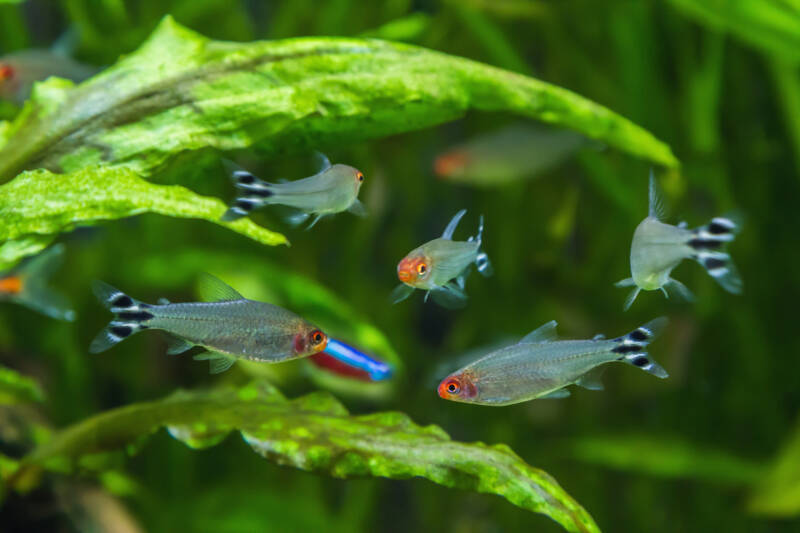
There are some specific care requirements when keeping this fish.Read on to learn the basics on how to care for and breed the rummy nose tetra and answers to some common questions.
At a Glance
| Min tank size: | 20 gal (80 l) |
| Group size: | 6-10 |
| Water temperature: | 72-84°F (22-29°C) |
| pH: | 5.5-6.8 |
| Hardness: | 2-8 KH |
| Lifespan: | 5-8 years |
| Breeding: | Egg layer |
| Adult size: | 1.75-2.5 in (4-6.4 cm) |
| Usual place in the tank: | All, but mostly middle levels |
[toc]
Appearance and Biology
The rummy nose tetra has a sleek, torpedo-shaped body that is colored silver.
Its dorsal, pectoral, and anal fins are small and clear. Its tail fin, however, is an eye-catching black and white striped. The head, and even its eyes, features a deep red color, which gives the fish its name.
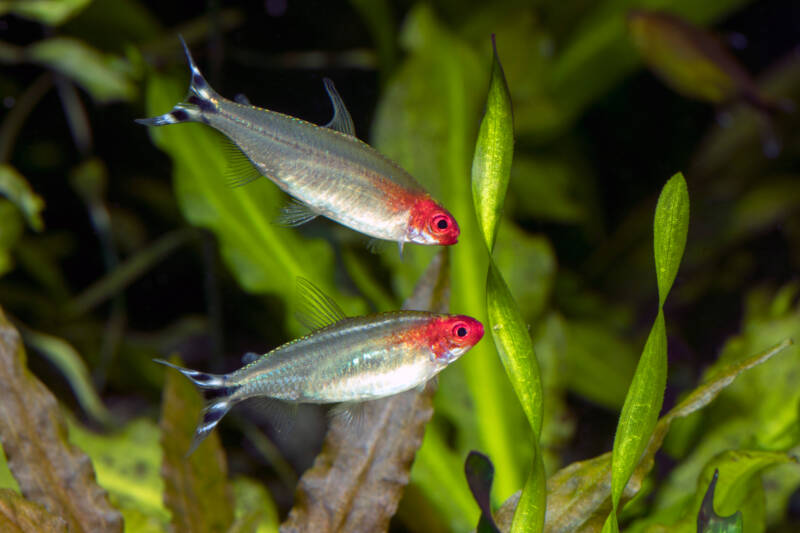
Three very similar tetra species are collectively known as rummy nose tetras:
- True rummy nose tetra (Hemigrammus rhodostomus).
- Brilliant rummy nose tetra (Hemigrammus bleheri): This species is the only one of the three in which the red coloration extends beyond the gills. It is also known as the firehead tetra, and at an adult length of 1.75 inches (4.4 cm), it is slightly smaller than the true rummy nose.
- False rummy nose tetra (Petitella georgiae): This tetra is also known as the black finned rummy nose.
Gender Differences
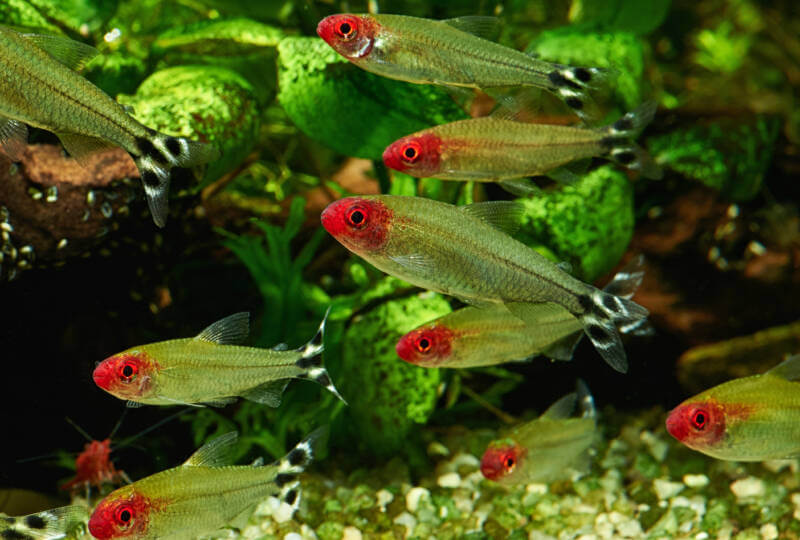
It is not only difficult to distinguish among the three species, but it is also difficult to determine which are males and which are females.Overall, the males tend to be thinner, and the females may be more rounded when they are ready to breed.
Check with your breeder to get a better idea of how many males and females you have in your mix.
In the Wild
The rummy nose tetra is native to South America’s Amazon River and tributaries. These waters are warm and soft (lacking heavy minerals), have a moderate current, and are slightly acidic.
The riverbeds are soft and sandy, with ample rocks and sticks along the bottom. Plenty of vegetation lines the banks and can be found floating and submerged in the water.
The water is tinted brown due to the high amount of decaying vegetation.
The Atlantic coastal region is the home of the true rummy nose tetra. In contrast, the brilliant rummy nose can be found in blackwater tributaries of Brazil’s Rio Negro and Colombia’s Rio Vaupes.
The waters flowing through Brazil and Peru form the native habitat of the false rummy nose tetra.
Size
Depending on the type of rummy nose you have, expect this fish to reach an adult length of 1.75 to 2.5 inches (4 to 6.4 cm).
Lifespan
How long do rummy nose tetras live? For a smaller-sized fish, the rummy nose tetra has a long lifespan of five to eight years.
Proper care, feeding, and tank maintenance will help ensure your fish have a long and healthy life.
Behavior

This species loves to shoal. Their behaviors will be lively and their comfort levels higher if they are kept in a good-sized group. We recommend a minimum group size of six, although a larger group would be quite impressive.
It is important to note that this is not a species that can be kept on its own. Such a situation would stress your fish, which could significantly impact its health.
These species can also be sensitive to loud noises or activity outside of their tank, so consider the amount of traffic around your tank when choosing where to place it.
Rummy nose tetras are peaceful in nature and make great additions to a community tank. They typically shoal around the middle levels, occasionally exploring or retreating among plants and decorations.
Are rummy nose tetras fin nippers?
No. Although several tetra species are known to be fin nippers, the rummy nose is not one of them. As such, you can be comfortable placing it in a community tank with other peaceful fish.
Stocking
How many rummy nose tetras should be kept together?
You can follow the rule of thumb of one fish per two gallons of water. Using this, a 20-gallon tank can hold 10 tetras. This is the minimum tank size and maximum number of fish.
However, knowing that these fish love having space to swim, if you can go with a larger tank, then do so.
How many rummy nose tetras can I put in a 10-gallon tank?
If you need to go with a nano tank of 10-gallon, the same rule should still apply.
For a 10-gallon tank, then five tetras would be the maximum number of fish you would put in the tank to avoid overstocking.
Tank Setup
Use a blackwater aquarium setup, as this will appropriately mimic the rummy nose tetra’s natural habitat.
Decorations
Line the bottom of the tank with a fine, sandy substrate. Darker sand is best. Place driftwood and rocks to create hiding spaces.
Add live plants that will extend upward through the water column, which will give your tetras places to shelter. Place the plants so that there is an open area where your fish can swim and shoal.
Consider adding a few floating plants to provide some shade.
Water Conditions
Rummy nose tetras are sensitive to poor water conditions. Keep the temperature warm and within the range of 72 to 84 degrees Fahrenheit (22 to 29 degrees C).
The pH should remain between 5.5 and 6.8 and the hardness between 2 and 8 KH. Change out 10% of the water twice a week and test your water regularly.
Adding a few Indian almond leaves or alder cones will tint the water and give the tank a natural look. Replace the leaves every couple of weeks and discard the used ones.
Equipment
Install a heater to keep the water temperature consistent. Choose an external filter to control the nitrate and ammonia levels as well as provide water movement.
Peat filtration will keep the water soft. An undergravel filter is useful to control any waste settling to the bottom.
No special lighting is required if you have plants or places for your fish to take shelter. If your tank is not well planted, consider a dim light.
Tank Mates
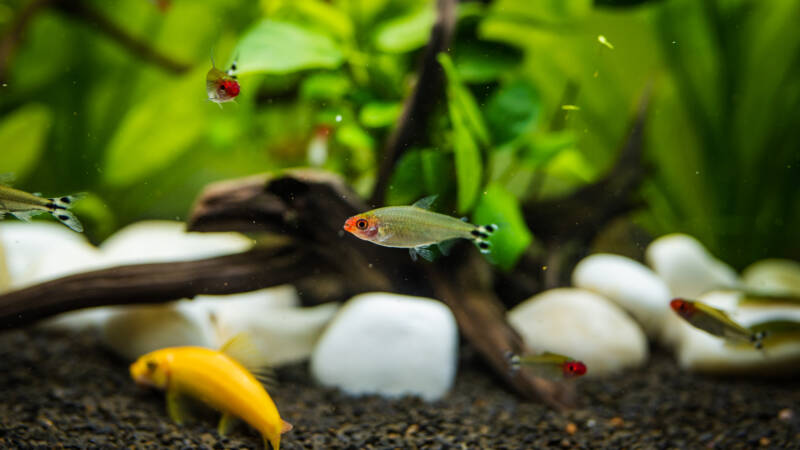
When selecting tank mates for your rummy nose tetras, make sure they are of similar size, temperament and prefer the same warm water conditions.
Aggressive or very active fish can stress rummy nose tetras, and you never want to pair them with fish large enough to consider them food.
Can rummy nose tetras live with neon tetras? Yes. Neon tetras are slightly smaller than the rummy noses, but they have similar water condition needs, behavior, and sensitivities.
It is important to note that neon tetras can be fin nippers, so you may have to separate them if you see this behavior.
Consider the following to pair with your rummy nose tetra:
Avoid the following:
Food and Diet

The rummy nose tetra is an omnivore. In the wild, they consume anything from insect larvae to plant matter.
In an aquarium, they readily accept quality commercial flake food, which should be the foundation of their diet.
Feed them twice per day and only as much as they can finish in two minutes. Remove uneaten food as the decaying matter will impact water conditions.
Treat them once or twice a week with high protein options, such as bloodworms, brine shrimp, or daphnia. You can even feed them homemade small-sized vegetable treats.
Breeding
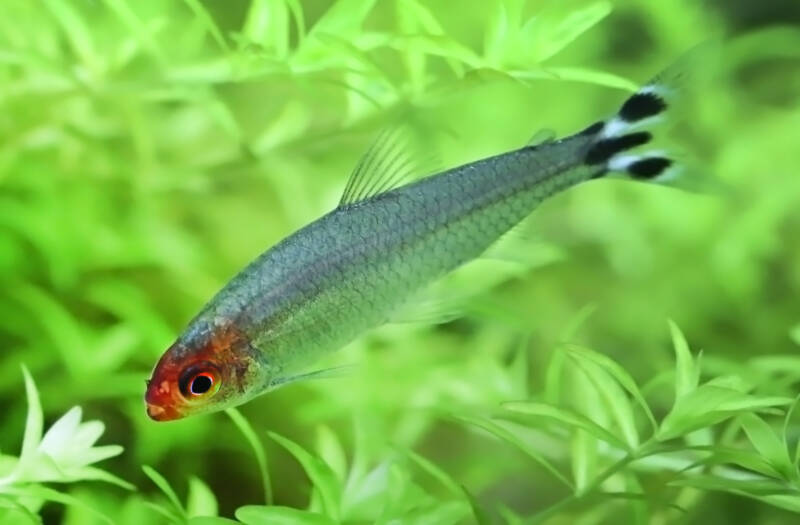
The rummy nose tetra can be finicky, so consider the following if you are trying to breed your fish.
Setting up a Breeding Tank
If you keep your fish in a community tank, set up a separate breeding tank (around 10 gallons is sufficient) with a sturdy, external filtration system.
Keep the water hardness around 4 to 6 KH. Peat filtration will keep the water soft. The pH should be around 6 to 6.2.
Add leafy plants, java moss, or a spawning mop around which your fish can lay their eggs. The fry and eggs will be light sensitive, so keep the lighting low.
Preparing your Fish for Spawning
Condition your fish with additional high-quality foods. Gradually raise the water temperature to 84 degrees Fahrenheit (29 degrees C) to stimulate spawning. You can breed them in pairs or in small groups.
Spawning
The female will lay her eggs on plant leaves or the spawning mop. Once the male has fertilized the eggs, remove the parents from the breeding tank.
Caring for the Fry
The fry should hatch within 24 to 36 hours. They will remain with their egg sacs at first and become free swimming in three to six days.
At this point, you can begin feeding them a commercial fry food or infusoria. As they grow larger, you can switch to baby brine shrimp or micro worms.
Rummy nose tetra fry are slow-growing compared to other tetras. For the first one to three months, they will be tiny and require small food sources. Keep the fry in the separate breeding tank until they are adult size, around six months of age.
Monitor the water conditions as your fry grow. They need clean water, stable conditions, and warm temperatures. Change out one-tenth of the water every two days or so.
Hardiness
Are rummy nose tetras hardy? While well cared for, well fed rummy nose tetras are hardy, they are sensitive to drastic shifts in their water conditions.
You will notice that if your fish are stressed, their color will fade. Correct any water conditions or dietary needs promptly.
Stressed rummy nose tetras are susceptible to common tank diseases, especially ich. Ich presents as white spots on your fish’s body.
Treat it as soon as possible by isolating the infected fish and giving in-water medication.
Closing Thoughts
Overall, the rummy nose tetra is a great choice for either a species only or community aquarium.
This peaceful and attractive fish makes for a great display when kept in a group in a well-planted tank.
Although it is sensitive to water quality, if you keep on top of the parameters, this is a hardy species.
What are some of your favorite tank mates in a community tank?
Send us a note in the comments and tell us your experience with keeping rummy nose tetras.
